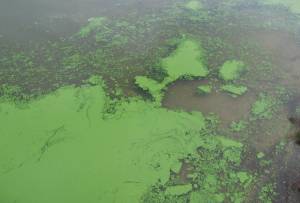Common Problems Caused By Algae In Water Bodies
|
|
Pomerix staff
Published: 04-Oct-2024
|
Algae overgrowth can lead to aesthetic damage, turning water bodies cloudy and discolored, which diminishes their natural beauty and recreational value. Beyond aesthetics, excessive algae can negatively affect aquatic plant communities by reducing sunlight penetration, making it difficult for submerged plants to perform photosynthesis, which is vital for their survival and growth. Additionally, algae compete with aquatic plant communities for essential resources, such as oxygen, CO2, and other vital nutrients such as nitrates, ammonium, and ammonia. This competition weakens aquatic plants, potentially leading to their decline, which disrupts the overall ecosystem balance and harms biodiversity.
Moreso, algae overgrowth can lead to more serious and harmful effects when blue green algae produce toxins, which pose significant risks to both aquatic life and human health. These toxins can kill fish by damaging their nervous systems, leading to large-scale fish kills that disrupt ecosystems. Additionally, these toxins can harm people and pets, causing skin irritation, gastrointestinal issues, or even more severe health problems if ingested. Beyond these immediate dangers, algal blooms often generate unpleasant odors too, primarily from the decomposition of algae, which can be off-putting to visitors and residents. When large quantities of algae die off, bacteria in the water column begin to break down the decomposing algae. During this decomposition process, gases such as hydrogen sulfide and ammonia are produced. These gases, often compared to the smell of rotten eggs or sewage, are responsible for strong, unpleasant odors, making areas affected by blooms difficult to tolerate.
Some algae, particularly blue green algae release volatile organic compounds as byproducts of their metabolism, and are notorious for giving water a musty or earthy smell. Even in small concentrations, these compounds can create noticeable and persistent odors. Water stagnation caused by dense algal blooms is another contributing factor for unpleasant odors. Thick layers of algae on the surface reduce oxygen circulation in the water leading to stagnation. In such low-oxygen or anaerobic conditions, organic matter continues to decay, producing additional foul-smelling gases. These factors, combined, make algal blooms an unsightly and unpleasant source of smells that affect water quality and disrupt recreational activities, such as swimming, boating, and other activities that rely on clean, fresh water, reducing the recreational value of lakes, ponds, and other freshwater bodies.
To conclude, here is a list of problems caused by algae:
- Aesthetic damage
- Block sunlight and oxygen under water
- Compete with aquatic plants for nutrients
- Harm fish, humans, and pets by producing toxins
- Cause unpleasant odors and decay
- Impede water flow
